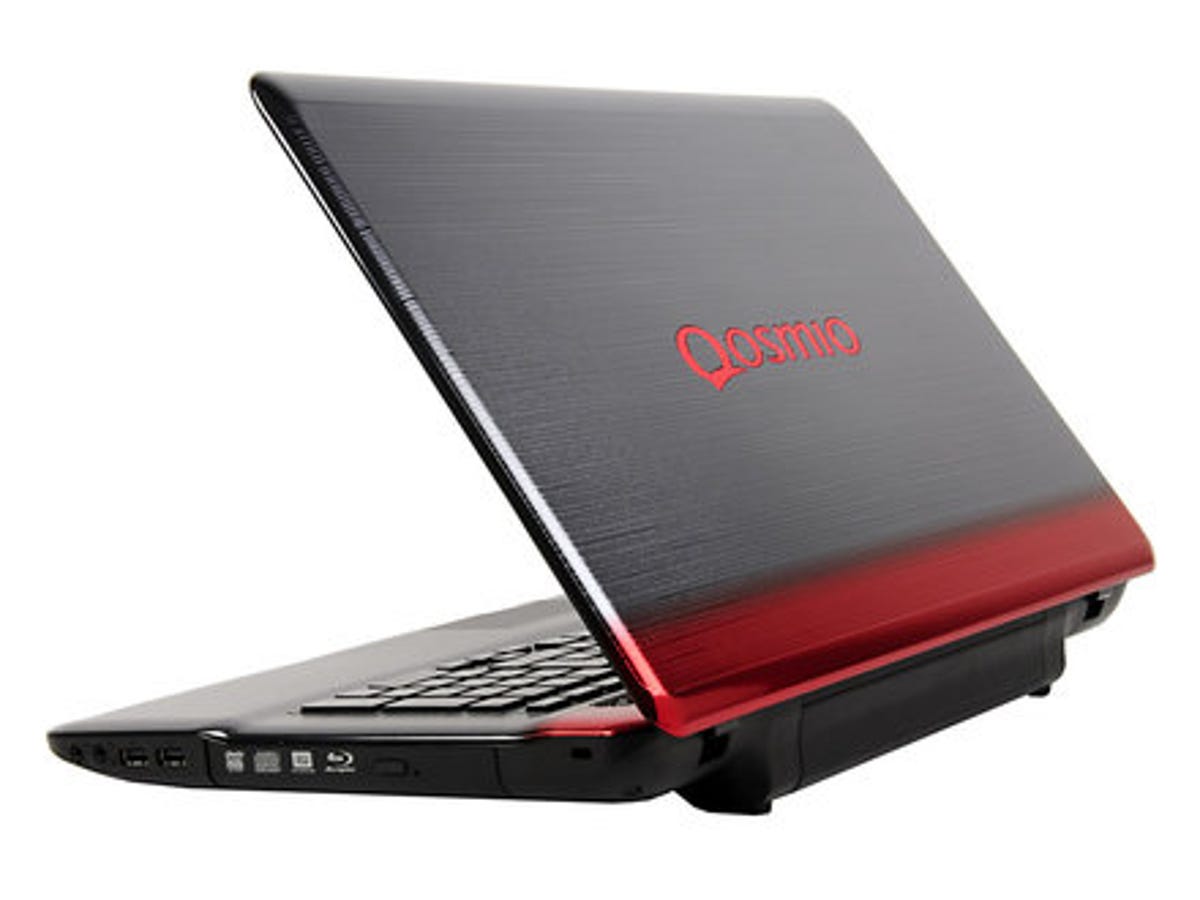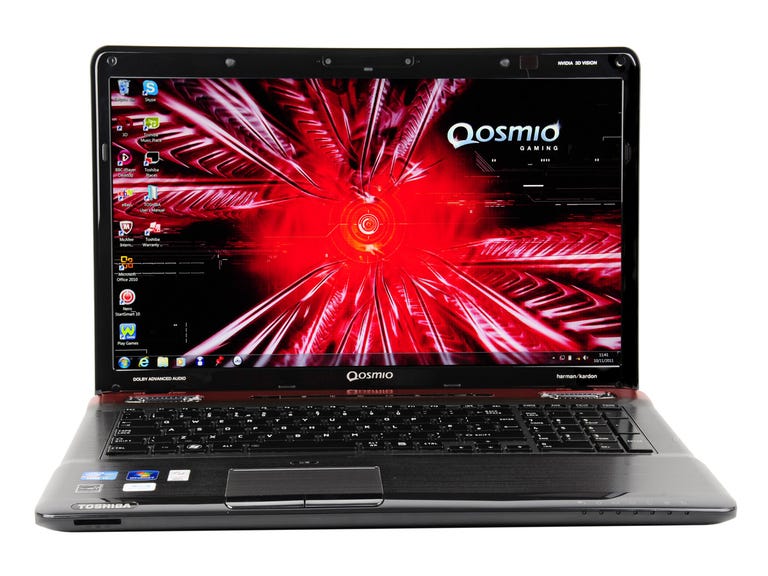 Why You Can Trust CNET
Why You Can Trust CNET Toshiba Qosmio X770 review: Toshiba Qosmio X770
The Qosmio X770's design may be aimed at excitable schoolboys, but it's packing powerful specs and offers a Full HD, 3D-capable screen.
The Toshiba Qosmio X770 is aimed squarely at the gamer in you, with an angry design sure to send hordes of schoolboys dizzy with sugar-fuelled excitement.
The Good
The Bad
The Bottom Line
It's packing a quad-core Intel Core i7 processor and 8GB of RAM, as well as an Nvidia GeForce GTX 560M graphics card to really power through the polygons.
It's available now from most retailers for around £1,500, although at the time of writing you can find it on Amazon for £1,400.
Design, portability and battery life
If you're after a super-light little laptop to slide into a case and take on your travels, the X770 isn't going to be high on your wish-list. Make no mistake about it; this thing is enormous. With a width of 413mm and a depth of 274mm, it's big enough to dominate most of your desk and will undoubtedly need to be carried in a suitcase, rather than a bag.
The X770's weight -- 3.4kg -- means that you'll probably need to get a burly friend to help you carry it too, unless you've recently been on a strict regime of back exercises and bull hormones. At 28mm, it's not the thickest laptop we've ever set eyes on, but it hardly qualifies as slim. Even worse, the battery bulges out at the back like a punch-related swelling.

That bulge means it'll be difficult to find a smart case or neoprene sleeve to slide it into for some gaming on the go. That's probably not much of an issue though, as this thing really isn't designed for portability -- much better to leave it chained to your desk than risk a hernia.
If you do decide to hunker down on the bus and frag some 'n00bs', know this: the battery is terrible. We ran our battery benchmark test and it only managed to last 25 minutes before giving up the ghost, which is one of the worst battery performances we've ever seen from a laptop.
It is a very brutal test, however, so you can expect a better time with cautious usage. Even under perfect conditions Toshiba reckons it will give a maximum of 2 hours 30 minutes -- and bear in mind that 'maximum' involves the computer doing very little.
When it's safely plugged into the mains, the X770 is certainly an imposing beast. It's coated in plastic that's been given a rough, lined texture. A dark, steel-grey colour dominates most of the machine, but the back end blends into a shiny red colour, giving the laptop the appearance of a slab of steel that's been partially heated to red-hot temperatures.
Whether you like that sort of look or not is a matter of taste -- it's the kind of style that would make any teenage shooter fan dribble with excitement.
The plastic feels thick and didn't give much in the way of flex, but we worry it's rather brittle -- we certainly wouldn't want to drop it as we don't think it could take it, which is worth bearing in mind considering its not inconsiderate weight means it's practically begging to be dropped.
Under the lid is more of that dark grey plastic trying its best to look macho and menacing. The keyboard uses square, black isolated keys that are well spaced and are just firm enough to not feel flimsy and plasticky. The whole keyboard is backlit with a deep red glow that looks like a furnace is burning inside, although sadly the light doesn't illuminate the characters through each key for easier night-time typing so it's mostly there for dramatic effect.
The trackpad is fairly large and has a rough texture to it that makes sliding your finger over it particularly easy. It's responsive too, and supports multi-touch gestures for two finger scrolling and pinch to zoom. The buttons beneath it are particularly big and are very easy to press -- handy if you're doing some furious clicking around web pages. You'll still want to stick in a USB mouse if you're booting up games.
Above the keyboard are two angry-looking grilles, behind which lie two speakers provided by audio specialists Harman/Kardon. They pump out a decent racket by laptop speaker standards, with a punchy bass and clear highs, but if you want a really immersive gaming or movie experience, you're going to need to hook up a proper set of speakers or get yourself some awesome headphones to hear those head-shots in beautiful, brain-rending definition.
Around the sides of the X770 you'll find a VGA out port, an HDMI port, an Ethernet port, one USB 3.0 port (only one? That's a bit stingy, Toshiba), three USB 2.0 ports, an SD card reader and headphone out/mic in jacks. You also get a Blu-ray drive to enjoy your favourite flicks in glorious high definition.
3D screen tested
If the idea of watching films in only two boring dimensions makes you sick to the point of needing medical assistance, we have great news for you -- the X770 uses Nvidia 3D vision to bring out that mystical third dimension for your films.
Unlike the Toshiba Qosmio F750, which allows you to watch 3D content with your eyes free of an ugly tangle of plastic, the X770 will force you to don a pair of daft 3D glasses.
Thanks to the pre-installed Nvidia software, setting up the 3D is a very simple process, involving you clicking on what you can see through each eye while wearing the glasses. Once it's ready, you can load up whatever 3D stuff you like and take your eyes for a spin.
Because we're super cool -- and really just kids pretending to be adults -- we loaded Cloudy With a Chance of Meatballs and set it to play in 3D. We found the 3D Vision worked rather well and gave a much smoother 3D experience than the glasses-free variety found on the F750. Even after 20 minutes of play, we weren't left with a horrible sense of nausea, as we often are with 3D content, so we chalked it up as a success.
If you want to get a couple of mates round for a movie, that's fine too, as the X770 can support multiple pairs of glasses. Sadly, you're going to have to fork out over £100 per extra pair -- those active shutter glasses don't come cheap.
It's not just for films -- you can also play your games in 3D. We booted up Dirt 3 and rather enjoyed the effect of the menus and in-game displays floating in front of our face. It certainly added an extra something to the experience, although it's worth bearing in mind that generating the 3D effect is more demanding on the processor, so frame rates will drop -- something we particularly noticed when playing the intense shooter Crysis 2.
The screen itself is a 17.3-inch beast, so it's a great size for movies and games. It has a Full HD 1,920x1,080-pixel resolution so your high-definition Blu-ray discs can be played in all their sparkling glory. It's bright too and handles colours very well, so if you're after a dedicated media laptop, the X770 is definitely worth considering.
It's also packing a meaty 1TB of storage so you can store a massive amount of music, films and whatever else takes your fancy.
Performance benchmarks
Under that angry looking shell you'll find a quad-core 2.0GHz Intel Core i7-2630QM processor teamed up with a very healthy 8GB of RAM. Those are some rather burly specs so we were hoping for a powerful performance to match the X770's menacing presence.
We loaded up our arsenal of benchmark tests and hit it square in the chops. With the PCMark05 test, the X770 returned a very impressive score of 11,650. That's way above the average for most laptops, but it doesn't quite beat the MSI GT680's score of 14,392 on the same test. However, the X770 whupped the MSI's proverbial on the Geekbench test, giving a score of 11,334 against the MSI's 7,713.
We found performance to be extremely swift, with heavy multi-tasking of intense processing handled well. Naturally, it will easily cope with multiple high-definition video streams and will happily turn its hand to more demanding tasks such as photo and video editing, although don't expect quite as swift a performance if you're editing high-res raw image files or rendering massive movie projects -- there's a reason production companies have dedicated rendering farms.
It managed to encode our 11-minute 1080p video file into 24fps H.264 in just under 11 minutes, which is a very impressive time. It will happily handle the lighter side of video editing. If you just want to string together some home videos of your mates riding around in shopping trolleys, the X770 will cope fine.
An Nvidia GeForce GTX 560M graphics card with 1.5GB of GDDR5 VRAM provides the power for your games. We ran the 3DMark06 graphics benchmark test and were given a phenomenal score of 15,548 -- the highest score we've seen on a laptop -- so we had sky-high expectations of its gaming performance.
When we loaded up Dirt 3 on the highest detail settings, we were treated to an average frame rate of around 38fps, which resulted in a very smooth experience as we sent our rally car hurtling into trees at high speed. When we enabled 3D Vision, however, that average took a steep dive to around 19fps, which was noticeably jumpy and laggy at times.
We then tested the more demanding first-person shooter Crysis 2, also on the top detail settings, and found an average frame rate of 18fps when playing in 2D. That won't satisfy hardcore gamers, but it's an admirable score for a laptop and only became annoyingly jumpy in very high-action sequences. When we turned on 3D, the frame rates dropped to an average of 13fps, which really wasn't good enough to enjoy properly -- although we did like the floating effect given to the heads-up display.
So long as you keep it in 2D, the X770 will happily tear into most games. If you're desperate to load up the latest, most demanding 3D games, you'll need to dial the settings down a little in order to keep the frame rates high, but those polygons will still look beautiful.
Conclusion
If a laptop that looks like a massive lump of slightly glowing steel appeals to you, the Toshiba Qosmio X770 should be right up your street. With its powerful components it will handle all but the most demanding of tasks without question and does a good job with games too.
The 3D capabilities are a fun addition and work well for movies, but the extra drain on the processor means it's less useful for gaming. If you're happy to sacrifice portability and good battery life in place of raw power, the X770 is definitely one to consider.


